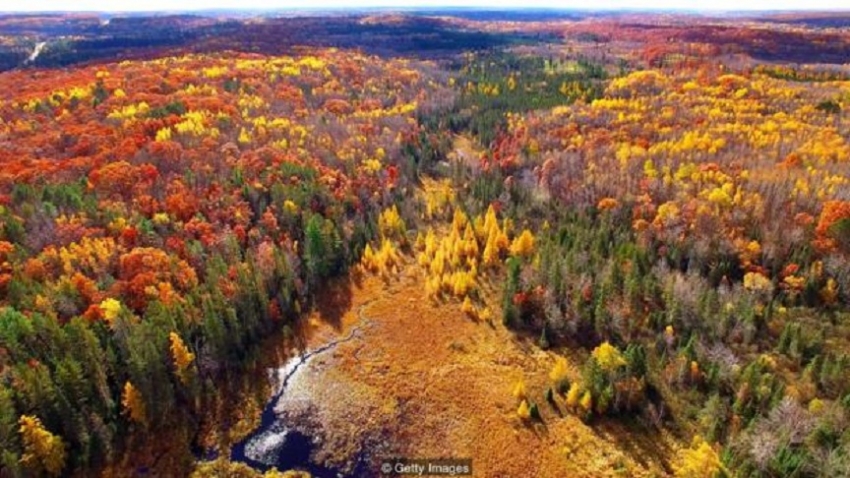Beneath Jim Anderson’s feet lies a monster. It has been alive since the Persian king Xerxes waged war against the Ancient Greeks and weighs more than three blue whales put together. It has a voracious appetite, eating its way through huge swathes of forest. But this is no long-forgotten beast borne of Greek mythology. It is a mushroom.
Anderson is standing in an unassuming patch of woodland in Crystal Falls, in Michigan’s Upper Peninsula. He is revisiting an organism living under the forest floor that he and his colleagues discovered nearly 30 years ago. This is the home of Armillaria gallica, a type of honey mushroom.
You might also like:
• The truth about nitrates in your food
• Wet countries that are running dry
• How meal times affect your waistline
These common fungi are found in temperate woodlands all across Asia, North America and Europe, where they grow on dead or dying wood, helping to speed up the decay. Often the only visible sign of them above ground are clumps of scaly, yellow-brown toad-stool-like fruiting bodies that grow up to 10cm tall.
A forest in Michigan's Upper Peninsula (Credit: Getty Images)
The humongous fungus discovered by Jim Anderson and his colleagues has been living under a forest in Michigan’s Upper Peninsula for 2,500 years (Credit: Getty Images)
When Anderson and his colleagues visited Crystal Falls in the late 1980s, they discovered that what at first appeared to be a rich community of Armillaria gallica flourishing beneath the mulch of leaf litter and top soil of the forest floor was – in fact – one giant individual specimen. They estimated it covered an area about 91 acres, weighed 100 tonnes and was at least 1,500 years old. It set a new record at the time for the largest organism on the planet – a similar fungus in a forest in Oregon now holds the record.
“It caused quite a stir at the time,” says Anderson. “Our paper came out on April Fool’s Day so everyone thought it was a joke. Then in 2015 we thought we should go back and test our prediction that this was truly a persistent, single organism.”
The new results revealed it was four times larger, 1,000 years older and if gathered together would weigh around 400 tonnes
They ended up returning to the site several times between 2015 and 2017, taking samples from distant points around the forest and then running the DNA they obtained through a sequencer back at their laboratory at the University of Toronto. Since their initial study in the 1980s, genetic analysis has advanced in bounds, with new techniques making the process far cheaper, faster and providing more information.
Their new samples revealed that not only was the Armillaria gallica they had discovereda single individual, but it was far larger and older than they had predicted. The new results revealed it was four times larger, 1,000 years older and if gathered together would weigh around 400 tonnes.
The vein-like mycelium of a fungus (Credit: Alamy)
Fungi produce vein-like threads called mycelium that are finding a myriad of uses from creating medical bandages to building materials (Credit: Alamy)
But the analysis produced an even more surprising insight, one that could help us humans in our fight against one of modern medicines greatest foes – cancer.
The Canadian researchers discovered what may be the secret behind the Armillaria gallica’sextraordinary size and age. It appears the fungus has an extremely low mutation rate – meaning it avoids potentially damaging alterations to its genetic code.
As organisms grow, their cells divide into two to produce new daughter cells. Over time, the DNA in the cells can become damaged leading to errors, known as mutations, creeping into the genetic code. This is thought to be one of the key mechanisms that causes aging.
But it seems the Armillaria gallica in Crystal Falls might have some inbuilt resistance to this DNA damage. In 15 samples taken from distant parts of the forest and sequenced by the team, just 163 letters of the 100 million in the genetic code of Armillaria gallica had changed.
The fungus has a mechanism that helps to protect its DNA from damage, giving it one of the most stable genomes in the natural world
“The mutation frequency is much, much lower than we could ever have imagined,” says Anderson. “To have this low level of mutation, we would expect the cells to be dividing on average once for every metre of growth. But what is astonishing is that the cells are microscopic – just a few micrometres in size – so you would need millions of them in every metre of growth.”
Anderson and his team believe the fungus has a mechanism that helps to protect its DNA from damage, giving it one of the most stable genomes in the natural world. While they have still to unravel exactly what this is, the remarkable stability of the genome of Armillaria gallica could offer new insights into human health.
A fungus sprouting from cicada nymphs (Credit: Mike Dickison/Wikimedia Commons)
A fungus that infects cicada nymphs produces a compound that has been turned into a blockbusting immunosupressent drug (Credit: Mike Dickison/Wikimedia Commons)
In some cancers, mutations can run riot in cells as the normal mechanisms that check for and repair DNA break down.
“Armillaria gallica may provide a potential counterpoint to the notorious instability of cancer,” says Anderson. “If you looked at a line of cancer cells that were equivalent in age, it would be so riddled with mutations that you probably wouldn’t be able to recognise it. Armillaria is at the opposite extreme. It might be possible to pick out the evolutionary changes that have allowed it be like this and compare them to cancer cells.”
Doing this could not only allow scientists to learn more about what goes wrong in cancer cells but may also provide potential new ways of treating cancer.
While Anderson and his colleagues are not planning on doing this work themselves – they are leaving it to others who are younger and more qualified to understand the genetic complexities of cancer – their findings provide an intriguing glimpse of the untapped power of fungi to help humanity.
The combined biomass of fungi exceeds that of all the animals on the planet put together
Fungi are some of the most common organisms on our planet – the combined biomass of these often tiny organisms exceeds that of all the animals on the planet put together. And we are discovering new fungi all the time. More than 90% of the estimated 3.8 million fungi in the world are currently unknown to science. In 2017 alone, there were 2,189 new species of fungi described by scientists.
A recent report published by the UK’s Royal Botanic Gardens Kew in London highlighted that fungi are already used in hundreds of different ways, from making paper to helping to clean our dirty clothes. Around 15% of all vaccines and biologically produced drugs come from fungi. The complex proteins used to trigger an immune response to the hepatitis B virus, for example, are grown in yeast cells, which are part of the fungi family.
Clothes in a washing machine (Credit: Getty Images)
Enzymes produced by fungi are added to many washing powders to snip the tips off cotton strands as they are washed, helping to remove stubborn stains (Credit: Getty Images)
Perhaps the most well-known is the antibiotic penicillin, which was discovered in a common type of household mould that often grows on old bread. Dozens of other types of antibiotics are now produced by fungi.
They are also sources of treatments for migraines and statins for treating heart disease. One relatively new immunosuppressant, used for treating multiple sclerosis, was developed from a compound produced by a fungus that infects cicada larvae.
“It is part of this family of fungi that get into insects and take them over,” says Tom Prescott, a researcher who evaluates the use of plants and fungi at the Royal Botanic Gardens Kew. “They produce these compounds to suppress the insect immune system and it turns out they can be used in humans too.”
But some researchers believe we have barely scratched the surface of what fungi can offer us.
Compounds produced by fungi can destroy viruses that cause diseases like flu, polio, mumps, measles and glandular fever
“There have already been [fungi] reported to have activity against viral diseases,” says Riikka Linnakoski, a forest pathologist at the Natural Resources Institute Finland. Compounds produced by fungi can destroy viruses that cause diseases like flu, polio, mumps, measles and glandular fever. Numerous fungi have also been found to produce compounds that could treat diseases that currently have no cure, such as HIV and the Zika virus.
“I believe these represent just a small fraction of the full arsenal of bioactive compounds,” says Linnakoski. “Fungi are a vast source of various bioactive molecules, which could potentially be used as antivirals in the future.”
She is part of a research team that is investigating whether fungi growing in the mangrove forests of Colombia could be sources of new antiviral agents. These goals have not yet been realised, however. While fungi have been well researched as a source of antibiotics that act against bacteria, no antiviral drugs derived from fungi have been approved.
Linnakoski puts this apparent omission by the scientific community down to the difficulty in collecting and growing many fungi from the natural environment and the historic lack of communication between mycologists and the virology community. But she believes it will only be a matter of time before a fungi-based antiviral drug makes its way into clinics.
Linnakoski also believes that searching for new species of fungi in inhospitable environments such as in the sediment on the sea bed in some of the deepest parts of the ocean, or in the highly changeable conditions of mangrove forests, might yield even more exciting compounds.
A child receiving a vaccine (Credit: Getty Images)
Many vaccines are synthesised using yeast cells as mini-manufacturing plants to produce the complex molecules needed (Credit: Getty Images)
“The extreme conditions are thought to provoke fungi to produce unique and structurally unprecedented secondary metabolites,” she says. “Unfortunately, many of the native ecosystems that harbor great potential for discoveries of novel bioactive compounds, such as mangrove forests, are disappearing at alarming rates.”
A fungus found growing in soil at a landfill site on the outskirts of Islamabad, Pakistan, can rapidly break down polyurethane plastic
But fungi have uses that can tackle other problems beyond our health.
A fungus found growing in soil at a landfill site on the outskirts of Islamabad, Pakistan, may be a solution to the alarming levels of plastic pollution clogging up our oceans. Fariha Hasan, a microbiologist at Quaid-I-Azam University in Islamabad, discovered the fungi Aspergillus tubingensis can rapidly break down polyurethane plastic.
These plastics, which used to make a wide range of products including furniture foams, electronics cases, adhesives and films, can hang around in soil and sea water for years. The fungi, however, was found to break it down within a matter of weeks. Hasan and her team are now investigating how to use the fungi for large-scale degradation of plastic waste. Other fungi, such as Pestalotiopsis microspore, which normally grows on rotting ivy leaves, have also been found to have a prodigious appetite for plastic, raising hopes they could be harnessed to tackle our growing waste problem.
In fact, mushrooms have quite a taste for the pollution we contaminate our world with. Species have been discovered that can clean up oil pollution from soil, degrade harmful heavy metals, consume persistent pesticides and even help to rehabilitate radioactive sites.
Mushrooms, however, could also help to avoid the need to use some plastics in the first place.
A number of groups around the world are now attempting to exploit a key feature of fungi – the vein-like webs of mycelium they produce – to create materials that can replace plastic packaging. As fungi grow, these mycelium threads branch outwards, to probe into nooks and crannies in the soil, binding it together. They are nature’s glue.
In 2010, Ecovative Design began exploring how they could use this to bind together natural waste products like rice husks or wood chips to produce an alternative to polystyrene packaging. Their early work has evolved into MycoComposite, which uses left over bits of hemp plant as the base material.
These are packed into reusable moulds along with fungal spores and flour, which are then left to grow for nine days. As they do so, they produce enzymes that start to digest the waste. Once the material has grown into the desired shape, it is then treated with heat to dry out the material and halt further growth. The resulting mushroom packaging is biodegradable and is already being used by companies such as Dell to package its computers.
Packaging grown from fungi mycelium (Credit: Getty Images)
Fungi mycelium can be grown on agricultural waste like corn husks to produce a lightweight and biodegradable packaging material (Credit: Getty Images)
The company has also developed a way of growing mycelium into foams that can be used in trainers or as insulation, and fabrics that mimic leather. Working with sustainable fabrics firm Bolt Threats, it combines waste corn stalks with the mycelium, allowing it to grow into a mat that is tanned and compressed. The whole process takes days rather than the years needed for animal leather.
Stella McCartney is among the designers now looking to use this mushroom leather and shoe designer Liz Ciokajlo recently used mycelium to create a modern reimaging of the 1970s Moon Boot fashion trend.
It is possible to tune the qualities of the mycelium material by altering what it has to digest
Athanassia Athanassiou, a materials scientist at the Italian Institute of Technology in Genoa, has been using fungi to develop new types of bandage for treating chronic wounds.
But she has also discovered it is possible to tune the qualities of the mycelium material by altering what it has to digest. The harder a substance is for the fungi to digest – such as wood chips rather than potato peelings – the stiffer the resulting mycelium material is, for example.
It raises the prospect of using fungi for more robust purposes.
California-based MycoWorks have been developing ways of turning mushrooms into building materials. By fusing wood together with mycelium, they have been able to create bricks that are fire-retardant and tougher than conventional concrete.
The fungi Trametes versicolor growing on a tree (Credit: Tien Huynh)
The fungi Trametes versicolor, which normally grows on trees, can be tuned to create fire-retardant, termite resistant and sound insulating bricks (Credit: Tien Huynh)
Tien Huynh, a biotechnologist at the Royal Melbourne Institute of Technology in Australia, has been leading a project to create similar fungal brick by combining mycelium from Trametes versicolor with rice hulls and crushed waste glass.
She says they not only provide a cheap and environmentally friendly building material, but they also help to solve another problem facing many homes in Australia and around the world – termites. The silica content of the rice and the glass makes the material less appetising to termites, which cause billions of dollars in damage to homes every year.
“In our research, we have also used the fungi to produce enzymes and new biostructures for different properties including sound absorption, strength and flexibility,” says Huynh. Her team is also working on using fungi to produce chitin – a substance used to thicken foods and in many cosmetics.
“Usually chitin is processed from shellfish, which has hypoallergenic properties,” she says. “The fungal chitin does not. We will have more fungal-based products later in the year but it is certainly a fascinating resource underutilised.”
Fungi can also be used in combination with traditional building materials to create a “smart concrete” that can heal itself as the fungi grows into any cracks that form, secreting fresh calcium carbonate – the key raw material in concrete – to repair the damage.
“The possibilities for what we might use mycelium for are endless,” says Gitartha Kalita, a bioengineer at Assam Engineering College and Assam Don Bosco University in Guwahati, India. He and his colleagues have been using fungi and hay waste to create an alternative to wood for building. “Everything that we now call agricultural waste is actually an incredible resource that mushrooms can grow on. We have already degraded our environment and so if we can replace the current materials with something that is going to hold up in some sustainable way. They can take our waste and turn it into something which is really valuable for us.
Beneath Jim Anderson’s feet lies a monster. It has been alive since the Persian king Xerxes waged war against the Ancient Greeks and weighs more than three blue whales put together. It has a voracious appetite, eating its way through huge swathes of forest. But this is no long-forgotten beast borne of Greek mythology. It is a mushroom.
Anderson is standing in an unassuming patch of woodland in Crystal Falls, in Michigan’s Upper Peninsula. He is revisiting an organism living under the forest floor that he and his colleagues discovered nearly 30 years ago. This is the home of Armillaria gallica, a type of honey mushroom.
You might also like:
• The truth about nitrates in your food
• Wet countries that are running dry
• How meal times affect your waistline
These common fungi are found in temperate woodlands all across Asia, North America and Europe, where they grow on dead or dying wood, helping to speed up the decay. Often the only visible sign of them above ground are clumps of scaly, yellow-brown toad-stool-like fruiting bodies that grow up to 10cm tall.
A forest in Michigan's Upper Peninsula (Credit: Getty Images)
The humongous fungus discovered by Jim Anderson and his colleagues has been living under a forest in Michigan’s Upper Peninsula for 2,500 years (Credit: Getty Images)
When Anderson and his colleagues visited Crystal Falls in the late 1980s, they discovered that what at first appeared to be a rich community of Armillaria gallica flourishing beneath the mulch of leaf litter and top soil of the forest floor was – in fact – one giant individual specimen. They estimated it covered an area about 91 acres, weighed 100 tonnes and was at least 1,500 years old. It set a new record at the time for the largest organism on the planet – a similar fungus in a forest in Oregon now holds the record.
“It caused quite a stir at the time,” says Anderson. “Our paper came out on April Fool’s Day so everyone thought it was a joke. Then in 2015 we thought we should go back and test our prediction that this was truly a persistent, single organism.”
The new results revealed it was four times larger, 1,000 years older and if gathered together would weigh around 400 tonnes
They ended up returning to the site several times between 2015 and 2017, taking samples from distant points around the forest and then running the DNA they obtained through a sequencer back at their laboratory at the University of Toronto. Since their initial study in the 1980s, genetic analysis has advanced in bounds, with new techniques making the process far cheaper, faster and providing more information.
Their new samples revealed that not only was the Armillaria gallica they had discovereda single individual, but it was far larger and older than they had predicted. The new results revealed it was four times larger, 1,000 years older and if gathered together would weigh around 400 tonnes.
The vein-like mycelium of a fungus (Credit: Alamy)
Fungi produce vein-like threads called mycelium that are finding a myriad of uses from creating medical bandages to building materials (Credit: Alamy)
But the analysis produced an even more surprising insight, one that could help us humans in our fight against one of modern medicines greatest foes – cancer.
The Canadian researchers discovered what may be the secret behind the Armillaria gallica’sextraordinary size and age. It appears the fungus has an extremely low mutation rate – meaning it avoids potentially damaging alterations to its genetic code.
As organisms grow, their cells divide into two to produce new daughter cells. Over time, the DNA in the cells can become damaged leading to errors, known as mutations, creeping into the genetic code. This is thought to be one of the key mechanisms that causes aging.
But it seems the Armillaria gallica in Crystal Falls might have some inbuilt resistance to this DNA damage. In 15 samples taken from distant parts of the forest and sequenced by the team, just 163 letters of the 100 million in the genetic code of Armillaria gallica had changed.
The fungus has a mechanism that helps to protect its DNA from damage, giving it one of the most stable genomes in the natural world
“The mutation frequency is much, much lower than we could ever have imagined,” says Anderson. “To have this low level of mutation, we would expect the cells to be dividing on average once for every metre of growth. But what is astonishing is that the cells are microscopic – just a few micrometres in size – so you would need millions of them in every metre of growth.”
Anderson and his team believe the fungus has a mechanism that helps to protect its DNA from damage, giving it one of the most stable genomes in the natural world. While they have still to unravel exactly what this is, the remarkable stability of the genome of Armillaria gallica could offer new insights into human health.
A fungus sprouting from cicada nymphs (Credit: Mike Dickison/Wikimedia Commons)
A fungus that infects cicada nymphs produces a compound that has been turned into a blockbusting immunosupressent drug (Credit: Mike Dickison/Wikimedia Commons)
In some cancers, mutations can run riot in cells as the normal mechanisms that check for and repair DNA break down.
“Armillaria gallica may provide a potential counterpoint to the notorious instability of cancer,” says Anderson. “If you looked at a line of cancer cells that were equivalent in age, it would be so riddled with mutations that you probably wouldn’t be able to recognise it. Armillaria is at the opposite extreme. It might be possible to pick out the evolutionary changes that have allowed it be like this and compare them to cancer cells.”
Doing this could not only allow scientists to learn more about what goes wrong in cancer cells but may also provide potential new ways of treating cancer.
While Anderson and his colleagues are not planning on doing this work themselves – they are leaving it to others who are younger and more qualified to understand the genetic complexities of cancer – their findings provide an intriguing glimpse of the untapped power of fungi to help humanity.
The combined biomass of fungi exceeds that of all the animals on the planet put together
Fungi are some of the most common organisms on our planet – the combined biomass of these often tiny organisms exceeds that of all the animals on the planet put together. And we are discovering new fungi all the time. More than 90% of the estimated 3.8 million fungi in the world are currently unknown to science. In 2017 alone, there were 2,189 new species of fungi described by scientists.
A recent report published by the UK’s Royal Botanic Gardens Kew in London highlighted that fungi are already used in hundreds of different ways, from making paper to helping to clean our dirty clothes. Around 15% of all vaccines and biologically produced drugs come from fungi. The complex proteins used to trigger an immune response to the hepatitis B virus, for example, are grown in yeast cells, which are part of the fungi family.
Clothes in a washing machine (Credit: Getty Images)
Enzymes produced by fungi are added to many washing powders to snip the tips off cotton strands as they are washed, helping to remove stubborn stains (Credit: Getty Images)
Perhaps the most well-known is the antibiotic penicillin, which was discovered in a common type of household mould that often grows on old bread. Dozens of other types of antibiotics are now produced by fungi.
They are also sources of treatments for migraines and statins for treating heart disease. One relatively new immunosuppressant, used for treating multiple sclerosis, was developed from a compound produced by a fungus that infects cicada larvae.
“It is part of this family of fungi that get into insects and take them over,” says Tom Prescott, a researcher who evaluates the use of plants and fungi at the Royal Botanic Gardens Kew. “They produce these compounds to suppress the insect immune system and it turns out they can be used in humans too.”
But some researchers believe we have barely scratched the surface of what fungi can offer us.
Compounds produced by fungi can destroy viruses that cause diseases like flu, polio, mumps, measles and glandular fever
“There have already been [fungi] reported to have activity against viral diseases,” says Riikka Linnakoski, a forest pathologist at the Natural Resources Institute Finland. Compounds produced by fungi can destroy viruses that cause diseases like flu, polio, mumps, measles and glandular fever. Numerous fungi have also been found to produce compounds that could treat diseases that currently have no cure, such as HIV and the Zika virus.
“I believe these represent just a small fraction of the full arsenal of bioactive compounds,” says Linnakoski. “Fungi are a vast source of various bioactive molecules, which could potentially be used as antivirals in the future.”
She is part of a research team that is investigating whether fungi growing in the mangrove forests of Colombia could be sources of new antiviral agents. These goals have not yet been realised, however. While fungi have been well researched as a source of antibiotics that act against bacteria, no antiviral drugs derived from fungi have been approved.
Linnakoski puts this apparent omission by the scientific community down to the difficulty in collecting and growing many fungi from the natural environment and the historic lack of communication between mycologists and the virology community. But she believes it will only be a matter of time before a fungi-based antiviral drug makes its way into clinics.
Linnakoski also believes that searching for new species of fungi in inhospitable environments such as in the sediment on the sea bed in some of the deepest parts of the ocean, or in the highly changeable conditions of mangrove forests, might yield even more exciting compounds.
A child receiving a vaccine (Credit: Getty Images)
Many vaccines are synthesised using yeast cells as mini-manufacturing plants to produce the complex molecules needed (Credit: Getty Images)
“The extreme conditions are thought to provoke fungi to produce unique and structurally unprecedented secondary metabolites,” she says. “Unfortunately, many of the native ecosystems that harbor great potential for discoveries of novel bioactive compounds, such as mangrove forests, are disappearing at alarming rates.”
A fungus found growing in soil at a landfill site on the outskirts of Islamabad, Pakistan, can rapidly break down polyurethane plastic
But fungi have uses that can tackle other problems beyond our health.
A fungus found growing in soil at a landfill site on the outskirts of Islamabad, Pakistan, may be a solution to the alarming levels of plastic pollution clogging up our oceans. Fariha Hasan, a microbiologist at Quaid-I-Azam University in Islamabad, discovered the fungi Aspergillus tubingensis can rapidly break down polyurethane plastic.
These plastics, which used to make a wide range of products including furniture foams, electronics cases, adhesives and films, can hang around in soil and sea water for years. The fungi, however, was found to break it down within a matter of weeks. Hasan and her team are now investigating how to use the fungi for large-scale degradation of plastic waste. Other fungi, such as Pestalotiopsis microspore, which normally grows on rotting ivy leaves, have also been found to have a prodigious appetite for plastic, raising hopes they could be harnessed to tackle our growing waste problem.
In fact, mushrooms have quite a taste for the pollution we contaminate our world with. Species have been discovered that can clean up oil pollution from soil, degrade harmful heavy metals, consume persistent pesticides and even help to rehabilitate radioactive sites.
Mushrooms, however, could also help to avoid the need to use some plastics in the first place.
A number of groups around the world are now attempting to exploit a key feature of fungi – the vein-like webs of mycelium they produce – to create materials that can replace plastic packaging. As fungi grow, these mycelium threads branch outwards, to probe into nooks and crannies in the soil, binding it together. They are nature’s glue.
In 2010, Ecovative Design began exploring how they could use this to bind together natural waste products like rice husks or wood chips to produce an alternative to polystyrene packaging. Their early work has evolved into MycoComposite, which uses left over bits of hemp plant as the base material.
These are packed into reusable moulds along with fungal spores and flour, which are then left to grow for nine days. As they do so, they produce enzymes that start to digest the waste. Once the material has grown into the desired shape, it is then treated with heat to dry out the material and halt further growth. The resulting mushroom packaging is biodegradable and is already being used by companies such as Dell to package its computers.
Packaging grown from fungi mycelium (Credit: Getty Images)
Fungi mycelium can be grown on agricultural waste like corn husks to produce a lightweight and biodegradable packaging material (Credit: Getty Images)
The company has also developed a way of growing mycelium into foams that can be used in trainers or as insulation, and fabrics that mimic leather. Working with sustainable fabrics firm Bolt Threats, it combines waste corn stalks with the mycelium, allowing it to grow into a mat that is tanned and compressed. The whole process takes days rather than the years needed for animal leather.
Stella McCartney is among the designers now looking to use this mushroom leather and shoe designer Liz Ciokajlo recently used mycelium to create a modern reimaging of the 1970s Moon Boot fashion trend.
It is possible to tune the qualities of the mycelium material by altering what it has to digest
Athanassia Athanassiou, a materials scientist at the Italian Institute of Technology in Genoa, has been using fungi to develop new types of bandage for treating chronic wounds.
But she has also discovered it is possible to tune the qualities of the mycelium material by altering what it has to digest. The harder a substance is for the fungi to digest – such as wood chips rather than potato peelings – the stiffer the resulting mycelium material is, for example.
It raises the prospect of using fungi for more robust purposes.
California-based MycoWorks have been developing ways of turning mushrooms into building materials. By fusing wood together with mycelium, they have been able to create bricks that are fire-retardant and tougher than conventional concrete.
The fungi Trametes versicolor growing on a tree (Credit: Tien Huynh)
The fungi Trametes versicolor, which normally grows on trees, can be tuned to create fire-retardant, termite resistant and sound insulating bricks (Credit: Tien Huynh)
Tien Huynh, a biotechnologist at the Royal Melbourne Institute of Technology in Australia, has been leading a project to create similar fungal brick by combining mycelium from Trametes versicolor with rice hulls and crushed waste glass.
She says they not only provide a cheap and environmentally friendly building material, but they also help to solve another problem facing many homes in Australia and around the world – termites. The silica content of the rice and the glass makes the material less appetising to termites, which cause billions of dollars in damage to homes every year.
“In our research, we have also used the fungi to produce enzymes and new biostructures for different properties including sound absorption, strength and flexibility,” says Huynh. Her team is also working on using fungi to produce chitin – a substance used to thicken foods and in many cosmetics.
“Usually chitin is processed from shellfish, which has hypoallergenic properties,” she says. “The fungal chitin does not. We will have more fungal-based products later in the year but it is certainly a fascinating resource underutilised.”
Fungi can also be used in combination with traditional building materials to create a “smart concrete” that can heal itself as the fungi grows into any cracks that form, secreting fresh calcium carbonate – the key raw material in concrete – to repair the damage.
“The possibilities for what we might use mycelium for are endless,” says Gitartha Kalita, a bioengineer at Assam Engineering College and Assam Don Bosco University in Guwahati, India. He and his colleagues have been using fungi and hay waste to create an alternative to wood for building. “Everything that we now call agricultural waste is actually an incredible resource that mushrooms can grow on. We have already degraded our environment and so if we can replace the current materials with something that is going to hold up in some sustainable way. They can take our waste and turn it into something which is really valuable for us.
Beneath Jim Anderson’s feet lies a monster. It has been alive since the Persian king Xerxes waged war against the Ancient Greeks and weighs more than three blue whales put together. It has a voracious appetite, eating its way through huge swathes of forest. But this is no long-forgotten beast borne of Greek mythology. It is a mushroom.
Anderson is standing in an unassuming patch of woodland in Crystal Falls, in Michigan’s Upper Peninsula. He is revisiting an organism living under the forest floor that he and his colleagues discovered nearly 30 years ago. This is the home of Armillaria gallica, a type of honey mushroom.
These common fungi are found in temperate woodlands all across Asia, North America and Europe, where they grow on dead or dying wood, helping to speed up the decay. Often the only visible sign of them above ground are clumps of scaly, yellow-brown toad-stool-like fruiting bodies that grow up to 10cm tall.
The humongous fungus discovered by Jim Anderson and his colleagues has been living under a forest in Michigan’s Upper Peninsula for 2,500 years (Credit: Getty Images)
When Anderson and his colleagues visited Crystal Falls in the late 1980s, they discovered that what at first appeared to be a rich community of Armillaria gallica flourishing beneath the mulch of leaf litter and top soil of the forest floor was – in fact – one giant individual specimen. They estimated it covered an area about 91 acres, weighed 100 tonnes and was at least 1,500 years old. It set a new record at the time for the largest organism on the planet – a similar fungus in a forest in Oregon now holds the record.
“It caused quite a stir at the time,” says Anderson. “Our paper came out on April Fool’s Day so everyone thought it was a joke. Then in 2015 we thought we should go back and test our prediction that this was truly a persistent, single organism.”
The new results revealed it was four times larger, 1,000 years older and if gathered together would weigh around 400 tonnes
They ended up returning to the site several times between 2015 and 2017, taking samples from distant points around the forest and then running the DNA they obtained through a sequencer back at their laboratory at the University of Toronto. Since their initial study in the 1980s, genetic analysis has advanced in bounds, with new techniques making the process far cheaper, faster and providing more information.
Their new samples revealed that not only was the Armillaria gallica they had discovereda single individual, but it was far larger and older than they had predicted. The new results revealed it was four times larger, 1,000 years older and if gathered together would weigh around 400 tonnes.
The vein-like mycelium of a fungus (Credit: Alamy)
Fungi produce vein-like threads called mycelium that are finding a myriad of uses from creating medical bandages to building materials (Credit: Alamy)
But the analysis produced an even more surprising insight, one that could help us humans in our fight against one of modern medicines greatest foes – cancer.
The Canadian researchers discovered what may be the secret behind the Armillaria gallica’sextraordinary size and age. It appears the fungus has an extremely low mutation rate – meaning it avoids potentially damaging alterations to its genetic code.
As organisms grow, their cells divide into two to produce new daughter cells. Over time, the DNA in the cells can become damaged leading to errors, known as mutations, creeping into the genetic code. This is thought to be one of the key mechanisms that causes aging.
But it seems the Armillaria gallica in Crystal Falls might have some inbuilt resistance to this DNA damage. In 15 samples taken from distant parts of the forest and sequenced by the team, just 163 letters of the 100 million in the genetic code of Armillaria gallica had changed.
The fungus has a mechanism that helps to protect its DNA from damage, giving it one of the most stable genomes in the natural world
“The mutation frequency is much, much lower than we could ever have imagined,” says Anderson. “To have this low level of mutation, we would expect the cells to be dividing on average once for every metre of growth. But what is astonishing is that the cells are microscopic – just a few micrometres in size – so you would need millions of them in every metre of growth.”
Anderson and his team believe the fungus has a mechanism that helps to protect its DNA from damage, giving it one of the most stable genomes in the natural world. While they have still to unravel exactly what this is, the remarkable stability of the genome of Armillaria gallica could offer new insights into human health.
A fungus sprouting from cicada nymphs (Credit: Mike Dickison/Wikimedia Commons)
A fungus that infects cicada nymphs produces a compound that has been turned into a blockbusting immunosupressent drug (Credit: Mike Dickison/Wikimedia Commons)
In some cancers, mutations can run riot in cells as the normal mechanisms that check for and repair DNA break down.
“Armillaria gallica may provide a potential counterpoint to the notorious instability of cancer,” says Anderson. “If you looked at a line of cancer cells that were equivalent in age, it would be so riddled with mutations that you probably wouldn’t be able to recognise it. Armillaria is at the opposite extreme. It might be possible to pick out the evolutionary changes that have allowed it be like this and compare them to cancer cells.”
Doing this could not only allow scientists to learn more about what goes wrong in cancer cells but may also provide potential new ways of treating cancer.
While Anderson and his colleagues are not planning on doing this work themselves – they are leaving it to others who are younger and more qualified to understand the genetic complexities of cancer – their findings provide an intriguing glimpse of the untapped power of fungi to help humanity.
The combined biomass of fungi exceeds that of all the animals on the planet put together
Fungi are some of the most common organisms on our planet – the combined biomass of these often tiny organisms exceeds that of all the animals on the planet put together. And we are discovering new fungi all the time. More than 90% of the estimated 3.8 million fungi in the world are currently unknown to science. In 2017 alone, there were 2,189 new species of fungi described by scientists.
A recent report published by the UK’s Royal Botanic Gardens Kew in London highlighted that fungi are already used in hundreds of different ways, from making paper to helping to clean our dirty clothes. Around 15% of all vaccines and biologically produced drugs come from fungi. The complex proteins used to trigger an immune response to the hepatitis B virus, for example, are grown in yeast cells, which are part of the fungi family.
Clothes in a washing machine (Credit: Getty Images)
Enzymes produced by fungi are added to many washing powders to snip the tips off cotton strands as they are washed, helping to remove stubborn stains (Credit: Getty Images)
Perhaps the most well-known is the antibiotic penicillin, which was discovered in a common type of household mould that often grows on old bread. Dozens of other types of antibiotics are now produced by fungi.
They are also sources of treatments for migraines and statins for treating heart disease. One relatively new immunosuppressant, used for treating multiple sclerosis, was developed from a compound produced by a fungus that infects cicada larvae.
“It is part of this family of fungi that get into insects and take them over,” says Tom Prescott, a researcher who evaluates the use of plants and fungi at the Royal Botanic Gardens Kew. “They produce these compounds to suppress the insect immune system and it turns out they can be used in humans too.”
But some researchers believe we have barely scratched the surface of what fungi can offer us.
Compounds produced by fungi can destroy viruses that cause diseases like flu, polio, mumps, measles and glandular fever
“There have already been [fungi] reported to have activity against viral diseases,” says Riikka Linnakoski, a forest pathologist at the Natural Resources Institute Finland. Compounds produced by fungi can destroy viruses that cause diseases like flu, polio, mumps, measles and glandular fever. Numerous fungi have also been found to produce compounds that could treat diseases that currently have no cure, such as HIV and the Zika virus.
“I believe these represent just a small fraction of the full arsenal of bioactive compounds,” says Linnakoski. “Fungi are a vast source of various bioactive molecules, which could potentially be used as antivirals in the future.”
She is part of a research team that is investigating whether fungi growing in the mangrove forests of Colombia could be sources of new antiviral agents. These goals have not yet been realised, however. While fungi have been well researched as a source of antibiotics that act against bacteria, no antiviral drugs derived from fungi have been approved.
Linnakoski puts this apparent omission by the scientific community down to the difficulty in collecting and growing many fungi from the natural environment and the historic lack of communication between mycologists and the virology community. But she believes it will only be a matter of time before a fungi-based antiviral drug makes its way into clinics.
Linnakoski also believes that searching for new species of fungi in inhospitable environments such as in the sediment on the sea bed in some of the deepest parts of the ocean, or in the highly changeable conditions of mangrove forests, might yield even more exciting compounds.
A child receiving a vaccine (Credit: Getty Images)
Many vaccines are synthesised using yeast cells as mini-manufacturing plants to produce the complex molecules needed (Credit: Getty Images)
“The extreme conditions are thought to provoke fungi to produce unique and structurally unprecedented secondary metabolites,” she says. “Unfortunately, many of the native ecosystems that harbor great potential for discoveries of novel bioactive compounds, such as mangrove forests, are disappearing at alarming rates.”
A fungus found growing in soil at a landfill site on the outskirts of Islamabad, Pakistan, can rapidly break down polyurethane plastic
But fungi have uses that can tackle other problems beyond our health.
A fungus found growing in soil at a landfill site on the outskirts of Islamabad, Pakistan, may be a solution to the alarming levels of plastic pollution clogging up our oceans. Fariha Hasan, a microbiologist at Quaid-I-Azam University in Islamabad, discovered the fungi Aspergillus tubingensis can rapidly break down polyurethane plastic.
These plastics, which used to make a wide range of products including furniture foams, electronics cases, adhesives and films, can hang around in soil and sea water for years. The fungi, however, was found to break it down within a matter of weeks. Hasan and her team are now investigating how to use the fungi for large-scale degradation of plastic waste. Other fungi, such as Pestalotiopsis microspore, which normally grows on rotting ivy leaves, have also been found to have a prodigious appetite for plastic, raising hopes they could be harnessed to tackle our growing waste problem.
In fact, mushrooms have quite a taste for the pollution we contaminate our world with. Species have been discovered that can clean up oil pollution from soil, degrade harmful heavy metals, consume persistent pesticides and even help to rehabilitate radioactive sites.
Mushrooms, however, could also help to avoid the need to use some plastics in the first place.
A number of groups around the world are now attempting to exploit a key feature of fungi – the vein-like webs of mycelium they produce – to create materials that can replace plastic packaging. As fungi grow, these mycelium threads branch outwards, to probe into nooks and crannies in the soil, binding it together. They are nature’s glue.
In 2010, Ecovative Design began exploring how they could use this to bind together natural waste products like rice husks or wood chips to produce an alternative to polystyrene packaging. Their early work has evolved into MycoComposite, which uses left over bits of hemp plant as the base material.
These are packed into reusable moulds along with fungal spores and flour, which are then left to grow for nine days. As they do so, they produce enzymes that start to digest the waste. Once the material has grown into the desired shape, it is then treated with heat to dry out the material and halt further growth. The resulting mushroom packaging is biodegradable and is already being used by companies such as Dell to package its computers.
Packaging grown from fungi mycelium (Credit: Getty Images)
Fungi mycelium can be grown on agricultural waste like corn husks to produce a lightweight and biodegradable packaging material (Credit: Getty Images)
The company has also developed a way of growing mycelium into foams that can be used in trainers or as insulation, and fabrics that mimic leather. Working with sustainable fabrics firm Bolt Threats, it combines waste corn stalks with the mycelium, allowing it to grow into a mat that is tanned and compressed. The whole process takes days rather than the years needed for animal leather.
Stella McCartney is among the designers now looking to use this mushroom leather and shoe designer Liz Ciokajlo recently used mycelium to create a modern reimaging of the 1970s Moon Boot fashion trend.
It is possible to tune the qualities of the mycelium material by altering what it has to digest
Athanassia Athanassiou, a materials scientist at the Italian Institute of Technology in Genoa, has been using fungi to develop new types of bandage for treating chronic wounds.
But she has also discovered it is possible to tune the qualities of the mycelium material by altering what it has to digest. The harder a substance is for the fungi to digest – such as wood chips rather than potato peelings – the stiffer the resulting mycelium material is, for example.
It raises the prospect of using fungi for more robust purposes.
California-based MycoWorks have been developing ways of turning mushrooms into building materials. By fusing wood together with mycelium, they have been able to create bricks that are fire-retardant and tougher than conventional concrete.
The fungi Trametes versicolor growing on a tree (Credit: Tien Huynh)
The fungi Trametes versicolor, which normally grows on trees, can be tuned to create fire-retardant, termite resistant and sound insulating bricks (Credit: Tien Huynh)
Tien Huynh, a biotechnologist at the Royal Melbourne Institute of Technology in Australia, has been leading a project to create similar fungal brick by combining mycelium from Trametes versicolor with rice hulls and crushed waste glass.
She says they not only provide a cheap and environmentally friendly building material, but they also help to solve another problem facing many homes in Australia and around the world – termites. The silica content of the rice and the glass makes the material less appetising to termites, which cause billions of dollars in damage to homes every year.
“In our research, we have also used the fungi to produce enzymes and new biostructures for different properties including sound absorption, strength and flexibility,” says Huynh. Her team is also working on using fungi to produce chitin – a substance used to thicken foods and in many cosmetics.
“Usually chitin is processed from shellfish, which has hypoallergenic properties,” she says. “The fungal chitin does not. We will have more fungal-based products later in the year but it is certainly a fascinating resource underutilised.”
Fungi can also be used in combination with traditional building materials to create a “smart concrete” that can heal itself as the fungi grows into any cracks that form, secreting fresh calcium carbonate – the key raw material in concrete – to repair the damage.
“The possibilities for what we might use mycelium for are endless,” says Gitartha Kalita, a bioengineer at Assam Engineering College and Assam Don Bosco University in Guwahati, India. He and his colleagues have been using fungi and hay waste to create an alternative to wood for building. “Everything that we now call agricultural waste is actually an incredible resource that mushrooms can grow on. We have already degraded our environment and so if we can replace the current materials with something that is going to hold up in some sustainable way. They can take our waste and turn it into something which is really valuable for us.




















